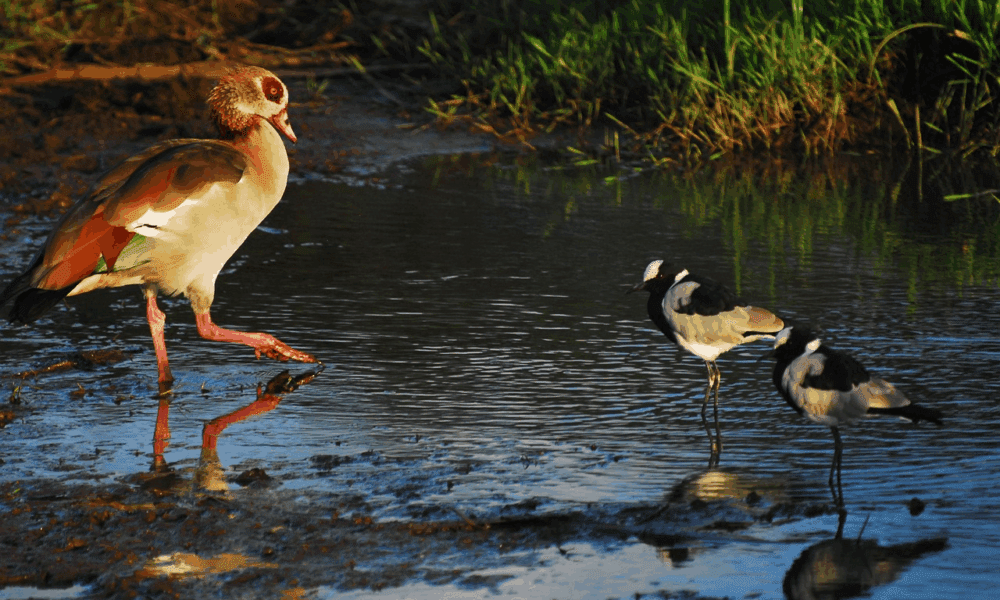From Nairobi to the Mara: Where Wildlife Calls:

The Wild Road Begins
From Nairobi city noise to the wide wild plains, the journey feels alive. Cars and tall buildings slowly fade away, and soon there is open sky and grassland that seem to never end. The call of birds, the warm wind, the smell of dust and sun—it all makes you feel you left the world behind. This road from Nairobi to the Masai Mara is not just travel; it is feeling, it is adventure. You don’t only go to see animals; you go to meet nature face-to-face.
Nairobi National Park—The City’s Wild Corner
Just a few kilometers from the city center, there is Nairobi National Park. It’s strange and amazing both. You see a giraffe walk near a skyscraper. You see a rhino near Airport Road. It is the only park like this in the world, with wild and city living side by side. The park is small compared to other Kenya parks but full of life. Lions, buffalo, zebras, and ostriches are all there. Morning game drives are best because animals move more when it’s cool.
The Nairobi National Park entrance fee is simple. For non-residents, the cost is usually around USD 43 per adult, with a lower rate for kids. Kenyan citizens and residents pay the local rate. The gate opens early, so people go before sunrise. It is a place where even a short time gives a big wild feeling. Many travellers visit this park before going on a long safari to Masai Mara. It’s a perfect start for your Kenya adventure.
Road to Masai Mara—The Long Drive to Freedom
From Nairobi to the Mara, the road takes around 5 to 6 hours by car. The ride is dusty and bumpy but beautiful. You pass through small towns, green hills, and open plains where Maasai people herd cattle. You can go by road, or you can fly. If you fly, it takes around 45 minutes from Wilson Airport in Nairobi. The plane is small; you see the land change from city to wilderness.
If you choose a road trip, it feels more real. You stop for tea, you meet locals, and you see the Rift Valley spread below you like a painting. The road twists and goes down to the Mara region. When you finally reach the gate of Masai Mara National Reserve, you know you’re in the heart of wild Africa.
Masai Mara Safaris – Land of the Big Five
The Masai Mara Safaris are the dream of every traveler. It is not only the animals; it is the spirit. When the sun rises over the plains, everything glows gold. The grass moves like ocean waves. You see an elephant walk slowly, a lion rests in the shade, and a cheetah looks for a hunt. The sound of birds fills the air. It’s all so alive, so pure.
Game drives happen in the morning and evening. The guides are local Maasai; they know every track, every smell, and every call. They tell stories about animals and land. From July to October, you see the Great Migration—millions of wildebeest and zebras cross the Mara River. It is one of the most powerful natural shows in the world.
Luxury camps, mid-range lodges, and tented sites are all around. Some camps are close to the river; others are deep in the grassland. At night you hear lions roar from afar. It sounds scary but beautiful. You feel small, but you feel part of nature.
The Spirit of the Maasai People
No trip to Mara is complete without meeting the Maasai people. They live near the reserve, wear red shukas, carry spears, and live close to their cattle. They dance, they sing, and they welcome visitors with warm smiles. They tell stories of lions and ancestors. Visiting a Maasai village teaches you much about simple life, courage, and tradition.
The Maasai guide the land with respect. They know every animal path, every star in the sky. Spending time with them makes your safari more meaningful, not only sightseeing but also learning the connection between people and nature.
Best Time to Visit Masai Mara
The best time to visit Masai Mara depends on what you want to see. The park is open all year, but seasons change the experience.
- July to October: This is Great Migration time. Millions of animals move from Serengeti to Masai Mara. Rivers full of action, predator and prey everywhere. The weather is dry, making it easy to see animals.
- November to February: Green season starts. Baby animals are born, and birds come from far lands. The scenery is more lush, and prices are a little lower.
- March to May: Long rains. Roads are muddy, but the land looks alive, full green. Good for photographers who like dramatic skies.
Each season brings something different. But even on a quiet day, the Mara is never boring.
How to Get to Masai Mara
Getting to Mara is simple, but you need a plan.
By Road:
Most travelers take a car or safari jeep from Nairobi. The main route goes through Narok town. The road is partly smooth and partly rough. Around 250 kilometers total. Many operators pick you up from hotels in Nairobi. You can also take a private transfer or join a group safari.
By Air:
If you want comfort and to save time, fly from Wilson Airport. Flights land at small airstrips near camps inside Mara. Airlines like Safarilink and Air Kenya offer daily flights. From the air you see the land wide and wild—rivers, herds, and golden plains.
By Tour Package:
Many safari companies in Nairobi offer a full package: transport, meals, lodge, and guide. This is easiest for first-time visitors.
No matter how you go, the feeling is the same—the journey itself feels like part of the adventure.
The Wildlife Experience
Masai Mara is famous for the Big Five—lion, leopard, elephant, buffalo, and rhino. But it’s more than that. You see a giraffe walk slowly in golden light, a warthog runs funny with its tail up, and a hippo splash in the river. Each day is different. Morning drives show calm animals in cool air; evening drives show the drama of the hunt.
Bird lovers also find heaven here. Over 450 species live in Mara—from tiny sunbirds to big ostriches. The light at sunrise makes everything look like a dream.
In Nairobi National Park, animals live near the city, but their wild spirit is still the same. Cheetahs run in open land, and buffalo cross the road. You can even see a white rhino close to the car. Many people do a one-day safari there; it’s a good start before a big trip to Mara.
Safari Costs and Entrance Fees
When planning your safari, budget is important. The Nairobi National Park entrance fee is usually around USD 43 for non-resident adults and USD 20 for children. Resident rates are lower.
For Masai Mara National Reserve, the entrance fee is around USD 80 per adult per day for non-residents and less for residents. If you stay inside the reserve, you pay directly to the county council.
Safari package prices depend on lodge type and duration. Budget safaris cost less; luxury lodges cost more. But every safari, cheap or luxury, gives the same wild feeling.
Stay in the Wild—Lodges and Camps
Masai Mara has many stay options. Some lodges are near the river, others on high plains. You can choose a tented camp where you sleep hearing hyenas laugh or a luxury camp with a soft bed and hot shower.
Popular lodges include Mara Serena Safari Lodge, Basecamp Explorer, and Ashnil Mara. Many camps support ecotourism and the local community. They use solar power, recycle water, and employ Maasai staff.
Even in Nairobi National Park, you can stay at camps like Nairobi Tented Camp—it feels wild but still close to the city.
The Golden Light of Africa
The light in the Mara is special. Early morning sun touches the grass, and everything shines. Photographers call it the golden hour. In the evening, the sunset makes the sky red and purple. You watch the sun go down behind acacia trees, and you know you are in a place like no other.
Every sunset in Mara tells a story—a story of peace, beauty, and wild freedom.
A Day in the Mara
Morning starts before sunrise. Coffee, then keep ready. The air is cool, and animals are awake. You drive and see silhouettes of giraffes. Lions walk along the road, and elephants move slowly. After a few hours, breakfast under the acacia tree. Then rest till afternoon.
Evening drives start when the light is soft. You may see a cheetah hunt or a hippo leave the river. Then back to camp, dinner near the fire. Guides tell stories, and stars cover the sky. You sleep with the sound of the wild.
That one day in Mara feels like a whole-life memory.
Why Visit Both—Nairobi Park and Masai Mara
Visiting both parks gives you a full taste of Kenya’s wild soul. Nairobi National Park shows how wildlife can live near people. It’s easy, quick, yet full of action. Masai Mara shows true wilderness—open, endless, raw beauty.
Start your journey at Nairobi Park and end at Masai Mara. You see how land changes, how life moves. You see the small and the grand. Together, they show why Kenya is called the land of safari.
Final Thoughts—Where the Wild Calls
From Nairobi’s city sound to Mara’s lion roar, the journey changes you. You come to see animals, but you leave with something deeper. You learn patience watching elephants cross the road. You learn silence by listening to the wind over the plains.
The wild call is not loud; it is soft. It whispers in your heart when you see sunrise over acacia trees. The road from Nairobi to the Mara is not just travel; it is transformation. It reminds you how big and beautiful the world is.
FAQs
- How long is it from Nairobi to Masai Mara?
By road around 5–6 hours, by flight around 45 minutes. - What is the best time to visit Masai Mara?
From July to October during the Great Migration, but all year is good. - How much is the Nairobi National Park entrance fee?
Around USD 43 for non-resident adults, lower for locals and children. - Can I do a day safari in Nairobi Park?
Yes, it’s perfect for a one-day trip, open early morning till evening. - Is it safe to travel to Masai Mara?
Yes, very safe with licensed guides and tour companies.





